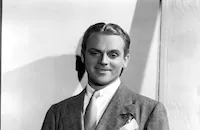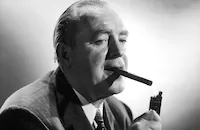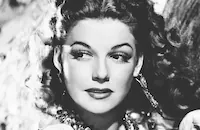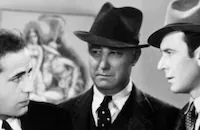Angels with Dirty Faces
Brief Synopsis
Cast & Crew
Michael Curtiz
James Cagney
Pat O'brien
Humphrey Bogart
Ann Sheridan
George Bancroft
Film Details
Technical Specs

Synopsis
Rocky Sullivan and Jerry Connolly, two New York slum kids, are caught trying to steal pens from a railroad car. Jerry escapes but Rocky is captured and sent to reform school. As adults, Rocky turns to a life of crime, while Jerry becomes a priest in their old neighborhood. Eventually, Rocky is arrested and makes a deal with his crooked lawyer, James Frazier, to take the fall for his gang in exchange for $100,000 upon his release. When Rocky returns to the neighborhood after his release from prison, Jerry hopes Rocky will go straight, but Rocky plans to join a criminal organization and collect the $100,000. Meanwhile, Rocky befriends a gang of troubled kids, using their admiration of him to get them involved in the wholesome activities that Jerry runs at the neighborhood gym. Rocky starts dating another childhood friend, Laury Ferguson, who is now a social worker for the parish. Unknown to Rocky, Frazier plans to kill Rocky, rather than give him his due. When Rocky discovers what he has in mind, he kidnaps Frazier and steals the contents of his safe, which include all the information Frazier and his cohort, Mac Keefer, have been using to blackmail powerful men around town. Frazier finally pays Rocky his money, $10,000 of which Rocky tries to give to Jerry for his gym. Fed up with corruption, Jerry begins a campaign to reform the city government. When Rocky finds out that Frazier and Keefer plan to kill Jerry in order to stop his work, he kills them and flees to a nightclub. Before he can get away, the police surround the nightclub, and Rocky is arrested and sentenced to death. Just before Rocky is to die, Jerry visits him on death row. He begs Rocky to die "yellow," so the gang kids won't idolize him. Rocky refuses outright, but as the guards start to strap him down in the electric chair, he begs them not to let him die. Later, when the kids read the paper's report of Rocky's death, Jerry reluctantly confirms his cowardice and asks the kids to join him in a prayer for the boy who "couldn't run as fast as I could."

Director

Michael Curtiz
Cast

James Cagney

Pat O'brien

Humphrey Bogart

Ann Sheridan

George Bancroft

Billy Halop

Bobby Jordan

Leo Gorcey

Gabriel Dell

Huntz Hall
Bernard Punsley
Joe Downing
Edward Pawley
Adrian Morris
Frankie Burke
William Tracey
Marilyn Knowlden
Oscar O'shea
William Pawley
Theodore Reid
Charles Sullivan

John Hamilton
Earl Dwire
William Worthington
James Farley
Pat O'malley
Jack C. Smith
Chuck Stubbs
Eddie Syracuse
George Sorel
Robert Homans
Harris Berger
Harry Hayden
Dick Rich
Stevan Darrell
Joe A. Devlin
William Edmunds
Charles Wilson

Lee Phelps

Jack Mower
Belle Mitchell
Vera Lewis
Eddie Brian
Billy Mcclain
Claude Wisberg
Frank Hagney
John Harron
Dick Wessel
Wilbur Mack
Jr. George Offerman
Mary Gordon
Joe Cunningham
James Spottswood
John Dilson
Charles Trowbridge
Tommy Jackson
Ralph Sanford
Galan Galt

Wilfred Lucas
Emory Parnell
William Crowell
Lane Chandler
Ben Hendricks
Sidney Bracy
George Taylor
Oscar G. Hendrian
Dan Wolheim
Brian Burke
Jeffrey Sayre
Charles March
Alexander Lockwood
Earl Gunn
Donald Kerr
Jack Goodrich
Al Lloyd
Carlyle Moore
John Marston
A. W. Sweatt
Roger Mcgee
Vince Lombardi
Sonny Bupp
Lottie Williams
Crew
Sam Bischoff
E. A. Brown
Rowland Brown
Father J. J. Devlin
Warren Duff
Emmett Emerson
Frank Evans
Frank Flanagan
Leo F. Forbstein
Hugo Friedhofer
Jo Graham
Al Greene
Robert Haas
William Harrington
Frank Kowalski
Jack Lucas
Charley Mark
Owen Marks
Frank Mattison
Harold Noyes
Orry-kelly
Herbert Plews
Sol Polito
Sherry Shourds
Max Steiner
Jack L. Warner
John Wexley

Photo Collections
Videos
Movie Clip






Trailer
Film Details
Technical Specs

Award Nominations
Best Actor
Best Director
Best Writing, Screenplay
Articles
Angels With Dirty Faces
According to his autobiography, Cagney by Cagney, the actor revealed that "Rocky Sullivan, was in part modeled on a fella I used to see when I was a kid. He was a hophead and a pimp...He worked out of a Hungarian rathskeller on First Avenue between Seventy-seventh and Seventy-eighth Streets...All day he would stand on that corner, hitch up his trousers, twist his neck and move his necktie, lift his shoulders, snap his fingers, then bring his hands together in a soft smack. His invariable greeting was "Whadda ya hear? Whadda ya say?" The capacity for observation is something every actor must have to some degree, so I recalled this fella and his mannerisms, and gave them to Rocky Sullivan just to bring some modicum of difference to this roughneck. I did that gesturing maybe six times in the picture - that was over thirty years ago - and the impressionists are still doing me doing him." This seminal role by Cagney was so impressive at the time and for a long while afterwards, that even now, after so many years of everyone from Sammy Davis Jr. to Johnny Carson "doing Cagney doing Rocky", it's a good bet that some comedian somewhere in the world is still mimicking the jittery gangster and he has no idea where his caricature came from.
The theme of two boyhood friends who grow up to find themselves on opposite sides of the law was a popular one in the 1930's. The idea was used successfully in films such as Manhattan Melodrama (1934) and Dead End (1937) among others, but Angels With Dirty Faces would become the quintessential Warner Brothers melodrama. It would be copied again and again for decades to come. The difference between Angels With Dirty Faces and its gangster film predecessors was its moralistic twist. The rise of gangsterism at that time in the country was attributed to the abject poverty stemming from the Great Depression and the illegal activities of Prohibition. Because of the societal violence and mayhem reflected in such films as Little Caesar(1930) and Scarface (1932), which sometimes glorified criminal behavior, whether inadvertently or not; gangster films began to fall under closer scrutiny from the powers that be.
In 1934 the already nettlesome and censorious Hays Office became all the more intrusive. Under the leadership of Catholic activist Joseph I. Breen, the self-regulatory committee using its code of ethics known as the Production Code, began putting extra pressure on studios to never allow an audience to become sympathetic to "crime, wrongdoing, evil or sin." After reading an advanced copy of the script for Angels With Dirty Faces, Breen wrote several letters to Jack Warner of Warner Brothers complaining about the content of the film. In one of those letters he said that, "It is important to avoid any flavor of making a hero and sympathetic character of a man who is at the same time shown to be a criminal, a murderer and a kidnapper." A detailed summary list of potentially offensive scenes and their attendant page numbers then followed in the letter including comments like "delete all suggestion of a strip poker game" and "There should be no scenes of policemen dying at the hands of Rocky." Warner, wanting to avoid any more outside pressure, then passed on these concerns to the people under him - people like producer Sam Bischoff and director Michael Curtiz. It would be their unenviable task to appease the Hays Office and still make a realistic motion picture. A war was on the horizon and those in authority wanted to lead the viewer away from the supposed rugged individualism of crime kings, and instead, instill the idea that teamwork was greatly needed throughout the nation. It remained a nagging concern throughout the thirties and is still a relevant issue today with the media glorification of The Sopranos and hip-hop "gangstas."
The rise, fall and redemption of Rocky Sullivan followed a familiar pattern set by many previous gangster pictures. Except this time, the crime lord was going to be asked to sacrifice himself for the common good. That would be the compromise given to the Hays Office. But, as far as cutting down the action and violent confrontations contained in Angels With Dirty Faces, little quarter was given. The stunt work, shootouts and fistfights were realistic in every way. In fact, for one scene set in a warehouse with machine-guns blazing everywhere, real bullets were used for ammunition! Cagney had been involved in a scene like this before in the making of The Public Enemy (1931), when he was almost gunned down. So, in making Angels With Dirty Faces he told the director, Michael Curtiz, that he wouldn't stand in front of a window as ordered and let a machine-gun expert fire away at him. It's a good thing that he won his argument because it proved to be a real life-saver; during a take, a hail of live bullets blew through the window pane where Curtiz had wanted Cagney to put his head.
Hollywood's Irishman-in-residence, Pat O'Brien, made many movies with James Cagney in the thirties and forties but his most famous role remains Father Jerry Connolly in Angels with Dirty Faces. No one could ever forget O'Brien and Cagney's long walk down that darkened corridor near the film's end; it's one of the most famous tracking shots in Hollywood cinema. For Humphrey Bogart and Cagney, this would be their third film in under two years. Like their subsequent roles in The Roaring Twenties (1939) and The Oklahoma Kid (1939), they would portray hated rivals - one of the best antagonistic couplings of all time. And as always, Ann Sheridan gives a realistic and immensely likeable performance as the tough but soulful woman who stands as the link between bad guy Cagney and the voice of conscience, saintly Pat O'Brien.
Interestingly enough, The Dead End Kids were used as a moral focal point for Angels With Dirty Faces. Because of the pressure put upon the film industry to create solid role models who could affect the youth of the day, it was important to show that young people, who might otherwise be tempted to go down the wrong road, could be influenced by the good and not the bad. Therefore, it was decided that the same group of tough, street wise youngsters who had appeared in the play Dead End (1935) and in the 1937 movie version, would portray the socially disadvantaged gang of kids in Angels With Dirty Faces. Extremely popular with audiences of the time, the "Kids" made six pictures together in the thirties, and then became the East Side Kids from 1940-1945, making several low budget films together. Later those "Kids" evolved into the Bowery Boys who made some 48 films between 1946 and 1958.
The genuine article, the Dead End Kids were hard nosed guys from the slums, who enjoyed being pranksters, and gave everyone a playful hard time while making Angels With Dirty Faces. Rumor had it that on a previous film with Bogart, the Kids poked fun of Bogie's tough guy movie image and even tore the actor's pants off in an off-the-set incident, which encouraged him to steer clear of the Kids thereafter. Only Cagney, with a similar background to the Kids, would stand up to them. One day the Dead End ringleader, Leo Gorcey, decided to play around and ad-lib a scene with Cagney. In his autobiography, the actor wrote, "I gave Leo Gorcey a stiff arm right above the nose - bang! His head went back, hitting the kid behind him, stunning them both momentarily. Then I said, "Now listen here, we've got some work to do, so let's have none of this goddamned nonsense....Understood?" "Yeah," they said. One of the kids turned to Gorcey and said, "Who the hell you think you got there - Bogart?"
Whether the Hays Office was satisfied with the results of Angels with Dirty Faces now means very little. The fact is that audiences have debated the final climactic scenes of the movie for generations. In those scenes, Pat O'Brien, the former child-thief turned priest, asks his old pal Cagney to perform an act of cowardice so The Dead End Kids would not follow in his footsteps. The ending seems to indicate that Cagney finally sees the light and redeems himself by playing role model to the nth degree. Or does he? Are the actions of Cagney only a feeble attempt at mock-redemption? Are the pronouncements given by Pat O'Brien at the picture's end merely pious bromides? Cagney said he wanted to leave it up to the audience to judge if Rocky Sullivan does what he does at the end to help the Kids or whether he does it simply out of fear and despair. In any case, Cagney's last mile walk is a powerful and iconic moment in the annals of movie lore. And regardless of one's opinion of the final scene, the one clear theory that stands out as a thematic structure throughout the film, is that chance and environmental circumstances play an enormous part in all our lives. As O'Brien says to the Dead End Kids as he leads them to mass at the end of the film, "Let's give a prayer to a boy who couldn't run as fast as I."
Producer: Sam Bischoff
Director: Michael Curtiz
Screenplay: Rowland Brown, Warren B. Duff, John Wexley
Art Direction: Robert M. Haas
Cinematography: Sol Polito
Editing: Owen Marks
Music: Max Steiner
Cast: James Cagney (Rocky Sullivan), Pat O'Brien (Rev. Jerry Connolly), Humphrey Bogart (James Frazier), Ann Sheridan (Laury Ferguson), George Bancroft (Mac Keefer).
BW-98m. Closed captioning.
By Joseph D'Onfrio

Angels With Dirty Faces
Quotes
Let's go and say a prayer for a boy who couldn't run as fast as I could.- Jerry Connolly
Now I know you're a smart lawyer, Frazier, very smart - but don't get smart with me.- Rocky Sullivan
Trivia
The Dead End kids terrorized the set during shooting. They threw other actors off with their add-libbing, and once cornered costar Humphrey Bogart and stole his trousers. But they didn't figure on James Cagney's street-bred toughness. The first time Leo Gorcey pulled an add-lib on Cagney, the star stiff-armed the young actor right above the nose. From then on, the gang behaved.
Because of the controversy over gangster films, the film was banned outright in Denmark, China, Poland, Finland, and parts of Canada and Switzerland.
To play Rocky, Cagney drew on his memories of growing up in New York's Hell's Kitchen. His main inspiration was a drug-addicted pimp who stood on a street corner all day hitching his trousers, twitching his neck, and repeating, "Whadda ya hear! Whadda ya say!" Those mannerisms came back to haunt Cagney. He later wrote in his autobiography," I did those gestures maybe six times in the picture. That was over thirty years ago - and the impressionists have been doing me doing him ever since."
Notes
This film was one of the top moneymakers of 1938. James Cagney was named best actor by the New York Film Critics and the National Board of Review, and received his first Academy Award nomination, losing to Spencer Tracy. Rowland Brown was nominated for an Oscar for Best Orginal Story and director Michael Curtiz also was nominated. According to Daily Variety, the film was censored by the Quebec censors and therefore did not screen in Montreal. Files from the MPPA/PCA Collection at the AMPAS Library note that the film was also rejected by censors in France, Jamaica, Denmark, Geneva, Poland, Finland, China and Norway. Modern sources note that live ammunition was used in the shootout scenes because the special effects that would simulate bursting bullets had not yet been perfected. Modern sources include Jack Perrin (Death Row guard), Bill Cohee, Lavel Lund, Norman Wallace, Gary Carthew and Bibby Mayer (Church basketball team), Poppy Wilde (Girl at gaming table), Frank Coghlan, Jr., David Durand, George Mori, Al Hill, and Thomas Jackson in the cast. In 1939, Warner Bros. produced a sequel, Angels Wash Their Faces. For more information on "The Dead End Kids" for Crime School and consult Series Index for entries under "The Dead End Kids," "The East Side Kids" and "The Little Tough Guys."

Miscellaneous Notes
Released in United States 1938
Broadcast in USA over TBS (colorized version) July 7, 1989.
Released in USA on video.
Released in United States 1938














